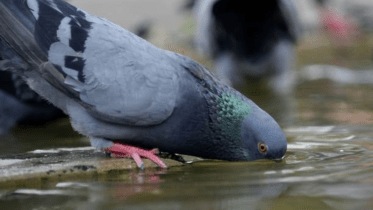The India Meteorological Department (IMD) has issued a warning for “severe heat-wave conditions” after Delhi recorded an unprecedented 52 degrees Celsius on May 29, 2024. This extreme heat is taking a toll on urban wildlife, particularly birds and animals. They are desperately seeking shade and water to survive, especially birds who fluff their feathers, rest in dense foliage or fly at higher altitudes to find cooler air.
To mitigate these conditions, the Delhi Zoo has implemented several measures — Coolers and sprinklers have been installed in animal enclosures. Water in the mud ponds and pools is changed every 3 to 10 days based on usage. Delhi Zoo Director Sanjeet Kumar shared with PTI, “The zoo authorities have introduced comprehensive measures to protect the animals from the extreme heat and create a more comfortable environment during the hottest part of the year.” Wall-hanging thermometers in key enclosures help monitor temperature fluctuations.
In the carnivore section, water pools have been repaired and filled to ensure running water during peak hours, helping to lower temperatures. Additionally, fruit ice balls are distributed daily to primates as a refreshing treat. “With these steps, we hope to ensure that the animals do not suffer from heat-related illnesses and can live comfortably through the peak summer months,” Kumar said.
Wildlife SOS, a conservation non-profit organization in India, has also ramped up its rescue operations. They have been saving hundreds of birds, reptiles, and mammals from the scorching heat. Natasha Ashok, communication associate at Wildlife SOS, emphasized the urgency in a blog, stating, “Given these alarming projections, we must take proactive measures to protect both ourselves and the animals under Wildlife SOS’s care from the impending heatwave.”
To combat the heat, Wildlife SOS has installed water sprinklers and coolers and added fruits to the animals’ diets to keep them hydrated. “During the summer, bears consume an extra 1.5 kg of fresh, juicy fruits like watermelons, papayas, muskmelons, and sun melons, which are nutrient-rich and aid in hydration. Additionally, Oral Rehydration Solution (ORS) is added to the water troughs in each den throughout the hot season,” Ashok told financialexpress.com.
Despite these efforts, many animals are still suffering. Birds are particularly vulnerable, often collapsing from heat stroke while searching for food and water. The Charity Bird Hospital inside the Digambar Jain temple in Chandni Chowk is providing free treatment to birds affected by the heat wave. Dr Haravatar Singh, a senior consultant at the hospital told ANI, that they have seen a significant increase in the number of birds suffering from heat stroke. “As the heatwave intensifies, the number of birds suffering from heatstroke will increase, resulting in more sick birds,” he said. Birds have a naturally high body temperature, around 107°F, but during a heatwave, it can rise much higher. If a bird’s body temperature exceeds 110°F, it becomes critical, requiring immediate care.
Dr Singh explained that one of the main reasons birds suffer during heatwaves is the lack of proper shelter and access to clean water. “Birds often get sick because they don’t find proper shelter or access to clean water. The water also gets heated due to the temperature rise, preventing them from drinking it,” he said. When the hospital receives a bird suffering from heatstroke, immediate actions are taken to stabilize its condition. “We sprinkle water on the bird and provide adequate ventilation. We have large fans that continuously circulate air through the cages. Sprinkling water on the birds and ensuring airflow helps cool their bodies,” Singh explained.
Delhi’s record-breaking temperatures are putting immense pressure on its urban wildlife. While organizations like the Delhi Zoo and Wildlife SOS are taking significant steps to mitigate the impact, the severity of the heatwave continues to challenge these efforts. The increasing number of heat-related illnesses in animals highlights the need for continued and enhanced measures to protect wildlife from extreme weather conditions.
